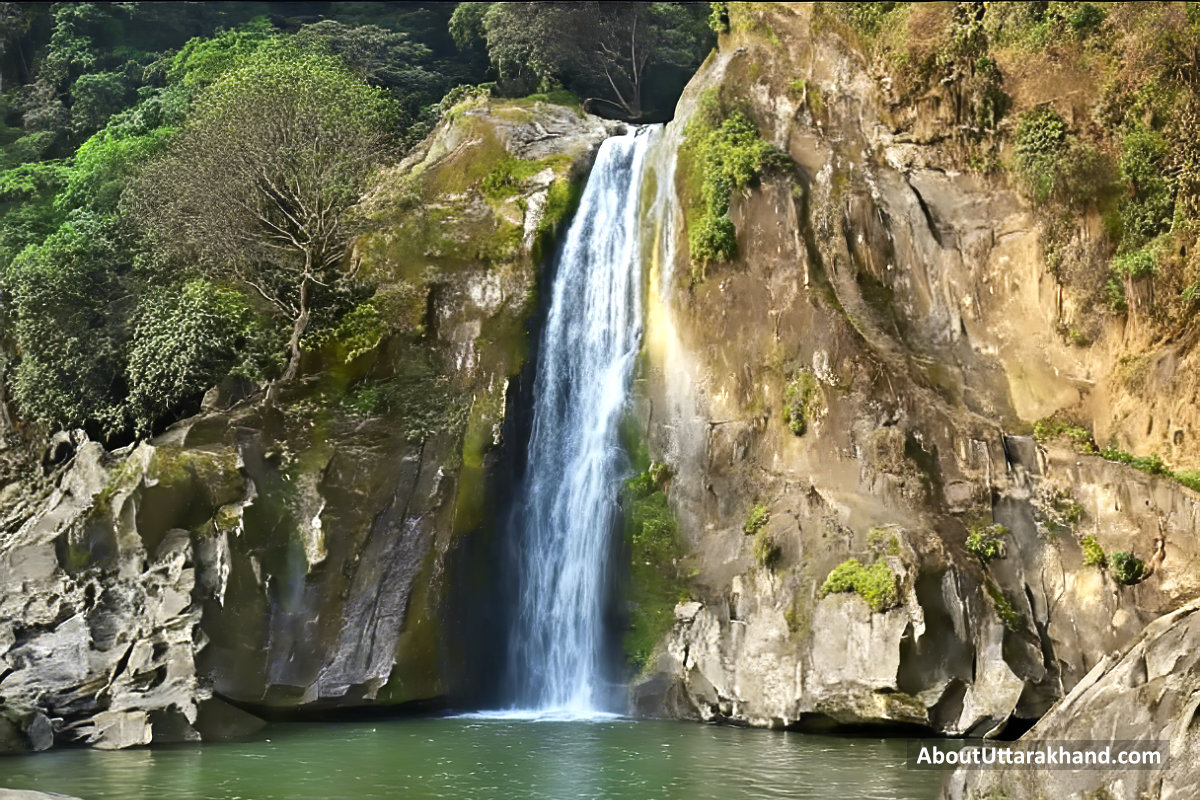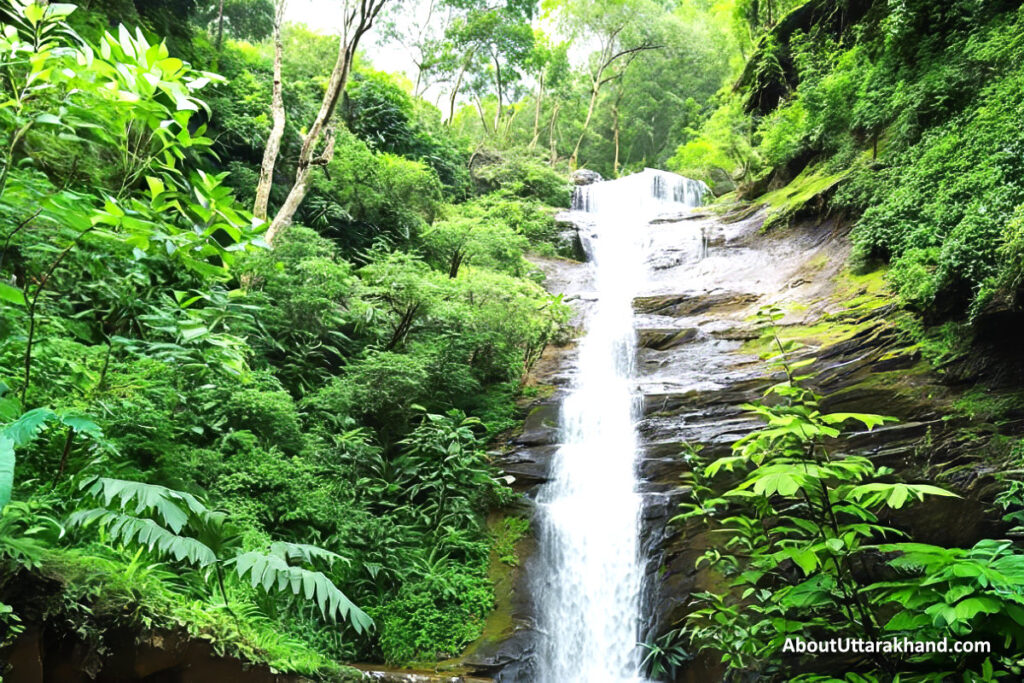Jharipani Falls
The beautiful Jharipani Falls is a stunning example of the mesmerising grandeur of the Himalayas. It is in the Dehradun District of Uttarakhand, in the Mussoorie area. This waterfall, which is surrounded by green plants and cooled by mountain air, is a great place to find peace and quiet in the Queen of Hills. As people start their journey to Jharipani Falls, they are greeted by the soothing sound of water trickling and the strong smell of pine. They are also given the promise of an amazing adventure in Mussoorie's untouched natural beauty.
Table of Contents
Jharipani FallsDetails About Jharipani Falls
History Of Jharipani Falls
Best Time To Reach Jharipani Falls
How To Reach Jharipani Falls
Places To Visit Near Jharipani Falls
To Conclude

Jharipani Falls in Uttarakhand, India | Photo: AboutUttarakhand.com
Details About Jharipani Falls
Jharipani Falls are easy to get to from Mussoorie, which is one of India's most well-known hill towns. Mussoorie is in the Dehradun District, which is linked to other major cities in the area, like Delhi and Dehradun. To get to the falls from Mussoorie, you can either drive or walk through beautiful scenery. Enjoy a beautiful hike to Jharipani Falls along winding paths that give you stunning views of the nearby hills and mountains. Both tourists and locals love going to Jharipani Falls because it's so easy to get to and the scenery is so beautiful.
The natural wonder that brings people to this spot is the Jharipani Falls, a beautiful waterfall that falls from the Himalayas. The green forests that surround the falls make the whole scene more beautiful. The water coming from the Shivalik Range flows down the rough rocks, making for an amazing sight. As you walk down to the falls, there is a pool where you can cool off and forget about the worries of everyday life. The peaceful atmosphere at Jharipani Falls comes from the lush plants and soft sound of the falls. It's a great place to disconnect.
On the way to Jharipani Falls, you can see some of the many plants and animals that live in the area. Along the path that goes to the falls, there are many kinds of plants, such as oak, rhododendron, and deodar trees. Native bird types are another thing that makes nature so appealing to people who like to watch them. The area around Jharipani Falls is an important part of the Shivalik Range ecosystem. It is home to many different kinds of animals and adds to the beauty of the foothills of the Himalayas.
Jharipani Falls is naturally beautiful, and nature fans and adventurers can also go trekking there. The walk to the falls is a bit exciting because it goes through the forest on trails with stunning views of the Doon Valley. It's impossible not to hear the peaceful sounds of nature as hikers move along the road. These sounds make the trip even more enjoyable. Amazing Jharipani Falls are the prise for all your hard work at the end of the hike. You can take it easy and enjoy the beautiful scenery.
Mussoorie's rich colonial past and lively culture make the experience of Jharipani Falls better. Colonial buildings, Mall Road, and nearby towns are all open to tourists, who can also take a leisurely walk. The nearby villages may have traditional Garhwali architecture, and talking to the people there will teach you a lot about their culture and customs. Adding traditional food, music, and festivals to the trip makes it more complete and adds to the cultural element.
History Of Jharipani Falls
The past of Jharipani Falls is deeply connected to the culture of Mussoorie and the Dehradun District as a whole. During the colonial era, British officials found and explored the area. They were drawn to Mussoorie's natural beauty and healthy climate. The falls have seen many years pass because they are in a peaceful place.
When the British Raj made Mussoorie a hill town, colonial officials who wanted to get away from the hot plains loved going there. The history of the town can be seen in its buildings, from colonial-era buildings to the famous Gun Hill, a popular lookout spot. In this historically important spot, Jharipani Falls has stood still as Mussoorie has changed from a retreat for British settlers to a popular holiday spot for nature lovers.
The area's rich cultural history, which was formed by the effects of colonialism and the following mixing of native practices, makes the experience of Jharipani Falls better. People come to Mussoorie to connect with its rich history. The falls, with their timeless beauty, act as a link between the past and the present.
Best Time To Reach Jharipani Falls
Even though Jharipani Falls is beautiful all year, its beauty changes as the seasons do. Summer is at its best from March to June, when you can go hiking and sightseeing outside. During the summer, from July to September, the land turns into a lush, green wonderland, and as it rains more, the waterfall gets even stronger. The scenery is full of warm colours from October to November. When the snow falls in December and January through February, it turns the colours into a magical winter wonderland. When is the best time to go? That depends on what you're looking for: peace and quiet in the winter or lively fun in the summer.
How To Reach Jharipani Falls
| By Road |
In Mussoorie, there is a path that goes straight to Jharipani Falls. Many important towns, like Delhi, are easy to get to from Mussoorie. It takes about seven to eight hours to drive 290 kilometres from Delhi. Along the way, you can see a stunning view of the Himalayas. Taxis, buses, and private cars are all possible ways to get to and from the road trip. When going from Mussoorie to Jharipani Falls, you can take a number of different types of local transportation. |
| By Train |
Dehradun Railway Station is the closest railway station to Mussoorie. From there, take a cab or public transportation to Mussoorie, which takes around 1.5 to 2 hours. Dehradun is well-connected to major cities, making it a handy destination for visitors. After landing in Dehradun, the road trip to Mussoorie is a pleasant experience before arriving at Jharipani Falls. |
| By Air |
Jolly Grant Airport in Dehradun is the closest airport to Jharipani Falls. From the airport, one may take a cab or other modes of transit to Mussoorie. The airport has direct flights to major cities including as Delhi, Mumbai, and Kolkata. The flight from Delhi to Dehradun takes around one hour. The road trip from Dehradun to Mussoorie takes around 1.5 to 2 hours and offers stunning vistas of the Himalayan environment. Jharipani Falls may be reached using local transportation from Mussoorie. |
Places To Visit Near Jharipani Falls
| Mossy Fall |
Mossy Fall in Mussoorie is a stunning example of the beauty that nature has to give. It is in the Tehri Garhwal District, which is also very pretty. Mossy Fall is a beautiful waterfall that comes out of nowhere. Mussoorie, which is known as the “queen of hills," has deep forests and rolling hills where you can find this secret gem. The picture of the water descending majestically from the Himalayas is very appealing to tourists who want to relax and be in nature. This is where you will see a lot of different species that Tehri Garhwal has to offer. Enjoy the outdoors by getting lost. The experience of this waterfall is more than just a waterfall; it's a real Himalayan journey. |
To Conclude
People who hike to Jharipani Falls will not only enjoy seeing a waterfall, but they will also have a better understanding of Mussoorie's rich natural and cultural past. The peaceful setting and roaring water of the falls are a constant reflection that beauty has no limits. They call to anyone brave enough to explore the Shivalik Range and find the magic that lies within.
The Jharipani Falls in the middle of the Dehradun District are a call to people who like to explore and people who want to relax and listen to the sound of water running. As we say goodbye to this natural haven, we are joined by the sounds of running water, the peace of the Himalayas, and the variety of cultures that make up the area.



























Belle Fable, keeps your trend ahead!
Gaumukh Glacier
The stunning Gaumukh Glacier, in the Uttarkashi region of Uttarakhand, India, is situated close to Gangotri and framed by the towering Garhwal Himalayas. Glaciers like this one attract tourists, hikers, and nature lovers from all over the globe because of the deep religious significance they have for Hindus as the headwaters of the holy Ganges River. The ascent to Gaumukh is an adventure in body and spirit, providing an opportunity to commune with the holy and the natural world.
Nandhaur Wildlife Sanctuary
The Nandhaur Wildlife Sanctuary is a haven for wildlife and stunning scenery, set in the tranquil hills of Uttarakhand. This sanctuary, in the Nainital District close to Haldwani, is a paradise for people who appreciate nature and animals. Its varied habitats, which include grasslands, ponds, and thick forests, have earned it recognition across its 269 square kilometers of territory.
Sonanadi Wildlife Sanctuary
The Sonanadi Wildlife Sanctuary invites animal lovers and nature lovers to come and enjoy the quiet beauty of Uttarakhand's serene surroundings. Hidden in the Nainital District, not far from Nainital, lies a refuge that begs to be discovered. Its varied wildlife and flora make this area, which covers around 301.18 square kilometers, a popular destination for ecotourists and those interested in biodiversity.
Binsar Wildlife Sanctuary
The Binsar Wildlife Sanctuary is a haven for wildlife and a monument to Uttarakhand's rich biodiversity, is situated in the picturesque Kumaon Himalayas. Nature lovers and wildlife aficionados will find this refuge, situated near Almora in the Almora District, to be a paradise. Covering about 47.04 square kilometers, it is famous for its verdant forests, varied fauna, and breathtaking views of the Himalayan mountains in the distance.
Tawaghat Wildlife Sanctuary
The Tawaghat Wildlife Sanctuary is a haven for adventurers and ecotourists, tucked away in the foothills of the towering Himalayas. This hidden gem of a sanctuary is located near Dharchula in Uttarakhand's Pithoragarh District. Despite its relatively tiny size (around 70 square km), this animal sanctuary is just as magical as any other.
Chilla Wildlife Sanctuary
.The Chilla Wildlife Sanctuary, located on the banks of the pure Ganges River, is a living monument to the beauty and variety of Uttarakhand's natural landscape. This sanctuary is a paradise for anyone who love nature and wildlife; it is located in the Pauri Garhwal District, close to Rishikesh. Covering over 249 square kilometers, it is a major wildlife sanctuary in the state that provides a peaceful haven amidst the majestic Himalayas.

